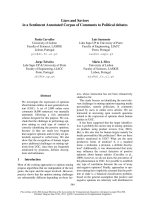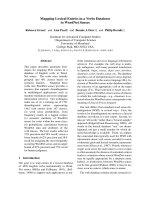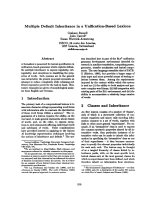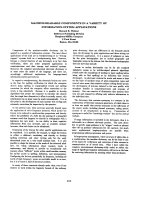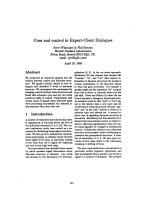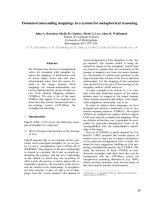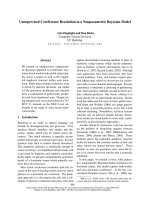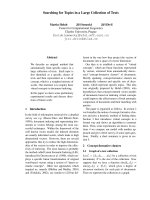Báo cáo khoa học: "Cerebellar vermian hypoplasia in a Cocker Spaniel" docx
Bạn đang xem bản rút gọn của tài liệu. Xem và tải ngay bản đầy đủ của tài liệu tại đây (2.11 MB, 3 trang )
JOURNAL OF
Veterinary
Science
J. Vet. Sci. (2008), 9(2), 215
217
Case Report
*Corresponding author
Tel: +82-2-880-1248; Fax: +82-2-888-2866
E-mail:
Fig. 1. Computed tomographs revealed cyst-like dilation of the
fourth ventricle and the radiolucent regions (arrow) in the
cerebellar structure without herniation of cerebellum.
Cerebellar vermian hypoplasia in a Cocker Spaniel
Ji-Hey Lim
1
, Dae-Yong Kim
2
, Jung-hee Yoon
3
, Wan Hee Kim
1
, Oh-kyeong Kweon
1,
*
Departments of
1
Veterinary Surgery,
2
Pathology, and
3
Radiology, College of Veterinary Medicine, Seoul National University,
Seoul 151-742, Korea
An eight-week-old female Cocker Spaniel was presented
with ataxia, dysmetria and intention tremor. At 16 weeks,
the clinical signs did not progress. Investigation including
imaging studies of the skull and cerebrospinal fluid analy-
sis were performed. The computed tomography revealed a
cyst-like dilation at the level of the fourth ventricle asso-
ciated with vermal defect in the cerebellum. After eutha-
nasia, a cerebellar hypoplasia with vermal defect was
identified on necropsy. A polymerase chain reaction am-
plification of cerebellar tissue revealed the absence of an
in utero parvoviral infection. Therefore, the cerebellar hy-
poplasia in this puppy was consistent with diagnosis of pri-
mary cerebellar malformation comparable to Dandy-Wal-
ker syndrome in humans.
Keywords: cerebellar hypoplasia, dog, vermian defect
Congenital cerebellar abnormalities have been described
in many species. Cerebellar hypoplasia associated with an
in utero or a neonatal viral infection is most common in
cats and cattle and has been reported in pigs, goats and
chickens [5,11]. However, congenital cerebellar disorders
such as genetic cerebellar malformations/cerebellar mal-
formations of unknown causes and cerebellar abiotrophies
also occur in sheep and several breeds of dogs [2,8,13].
Recently, in order to determine whether an infective etiol-
ogy is involved in cerebellar malformations of dogs, a pol-
ymerase chain reaction (PCR) to detect the DNA from sev-
eral infectious agents was performed. Schatzberg et al.
[10] described that the cause of the several disorders, pre-
viously considered idiopathic, was a secondary parvoviral
infection in dogs using PCR. In this study, we describe cer-
ebellar vermian hypoplasia diagnosed by computed to-
mography and necropsy in a Cocker Spaniel dog. PCR was
used to determine whether parvoviral infection was
present.
An eight-week-old female Cocker Spaniel was referred to
the Seoul National University Veterinary Medical Teach-
ing Hospital for evaluation of ataxia in all four limbs. The
puppy was alert, responsive, and appeared in good general
condition, but was unable to stand. Neurological examina-
tions revealed ataxia, dysmetria and intention tremor in all
four limbs. The puppy was re-examined at 16 weeks of age.
At this time, the clinical signs had neither progressed nor
improved. Survey radiography of the skull and cere-
brospinal fluid (CSF) analysis were performed and normal.
The canine distemper antibody titer in the CSF was also
within reference range. Additional computed tomographs
(CT) revealed cyst-like dilation at the level of the cer-
ebellum (Fig. 1). The puppy was euthanized and on nec-
ropsy, the cerebral hemispheres were found to be normal in
size. However, there was an obvious agenesis of the poste-
rior cerebellar vermis (Fig. 2). The defect communicated
with the fourth ventricle. The brain and cerebellum were
fixed in 10% buffered formalin, processed routinely, em-
bedded in paraffin, cut at 3 μm, and stained with hematox-
216 Ji-Hey Lim et al.
Fig. 2. The cerebellum without cerebellar vermis (arrow).
Fig. 3. Multifocal folial atrophy (arrows). H&E stain, ×12.5.
ylin and eosin (H&E) for light microscopic examination.
Histologically, folial atrophy (Fig. 3), degeneration and
loss of Purkinge cells and granular cells were found. To
identify whether an in utero parvoviral infection occurred,
DNA was extracted from the paraffin embedded cerebellar
tissue and PCR amplification was performed using three
primer pairs specific for parvovirus DNA [10]. These pri-
mer pairs are designed to amplify genes that code for struc-
tural proteins (VP1 and VP2) from both feline and canine
parvovirus. In brief, the PCR of DNA from the hypoplastic
cerebellum was performed for 30 cycles, each consisting
of denaturation at 94
o
C for 30 sec, annealing at 55
o
C for 2
min and polymerization at 72
o
C for 2 min and then PCR
products were electrophoresed on 1.2% agarose gel.
Parvoviral DNA was not amplified from the hypoplastic
cerebellum in this puppy.
The cerebellum functions as a regulator of movements
and maintenance of equilibrium. Signs of cerebellar dys-
function, therefore, usually include abnormalities of rate,
range, direction and force of motor movement [9]. Struc-
turally, the medial portion or the vermis is responsible pri-
marily for regulating posture and muscle tone. Abnormal-
ity of this area of the cerebellum may cause ataxic gait re-
ferred to as dysmetria, which can present with hypermetria
and intention tremor [1]. A primary developmental defect
and a secondary malformation of the cerebellum after in-
fection are the most common causes of congenital cer-
ebellar malformation in animals [5,6]. Cerebellar hypo-
plasia and atrophy secondary to feline panleukopenia virus
infection are well documented in cats [7]. In dogs, no viral
etiology has been identified except the canine herpes virus,
which causes extensive inflammation in multiple systems
of neonatal animals. However, recently, parvoviral in-
fection has been implicated using PCR [10,12]. Based on
the study of the Schatzberg et al. [10], canine parvovirus
infection should be considered in the differential diagnosis
for puppies with congenital cerebellar disease. Results
from studies on paraffin block specimens from dogs with
cerebellar hypoplasia were negative in six dogs with ver-
mal defect and two with abiotrophy for parvoviral DNA,
and positive in two blue tick coonhound littermates with
diffusely hypoplastic but no vermal defects [10]. The PCR
amplification result in the present study confirmed that our
dog with vermian defects had genetic etiology rather than
a viral infection.
The clinical signs of the puppy in this report seemed to be
due to the congenital anomalies of the cerebellum includ-
ing aplasia, partial agenesis or hypoplasia. Hypoplasia of
the cerebellar vermis was supported by two clinical
findings. First, this puppy did not show any signs of a sys-
temic infection. Second, the clinical signs did not progress
during 8 weeks of follow-up. Both clinical findings are
consistent with a congenital malformation that is non-pro-
gressive and associated with normal laboratory findings
[3,6]. In this study, CT scans identified the hypoattenuating
regions in the cerebellum without hydrocephalus. Al-
though magnetic resonance image (MRI) provided a more
detailed information of the entire brain, the CT scan may be
appropriate in diagnosing structural anomaly [13]. The
cyst-like dilation of the fourth ventricle noted on the CT
scan suggested a possible partial or complete defect of the
cerebellar vermis. On necropsy, agenesis of the posterior
cerebellar vermis consisting of the dorsal wall was also
noted. However, the communication to the central canal
from the fourth ventricle was normal in appearance. These
features are consistent with the Dandy-Walker-like malfor-
mation described in previous reports [4,5,8]. Dandy-Wal-
ker syndrome is a condition in children with partial or com-
plete absence of the cerebellar vermis. They also typically
have cyst-like dilations of the fourth ventricle as well as
Cerebellar vermian hypoplasia in a Cocker Spaniel 217
hydrocephalus. However, the syndrome is associated with
or without variable vermian hypoplasia and is described
with or without hydrocephalus in dogs [6]. Our case had
only agenesis of posterior cerebellar vermis. In human,
Dandy-Walker syndrome is considered to be primary pa-
renchymal, midline developmental defect of genetic origin
[5,10]. However, the pathogenesis in dogs has not been es-
tablished yet.
In the present report, a cerebellar malformation was sus-
pected in an eight-week-old Cocker Spaniel based on clin-
ical signs and CT scans. Necropsy confirmed cerebellar
vermian hypoplasia. There was no evidence of an in utero
parvoviral infection. Since the etiology of cerebellar ver-
mian hypoplasia is unknown in dogs, it is important to
evaluate littermates for a possible genetic etiology.
References
1. DeLahunta A. Veterinary Neuroanatomy and Clinical
Neurology. 2nd ed. pp. 260-262, Saunders, Philadelpia,
1983.
2. Franklin RJ, Ramsey IK, McKerrell RE. An inherited
neurological disorder of the St. Bernard dog characterised by
unusual cerebellar cortical dysplasia. Vet Rec 1997, 140,
656-657.
3. Harari J, Miller D, Padgett GA, Grace J. Cerebellar agen-
esis in two canine littermates. J Am Vet Med Assoc 1983,
182, 622-623.
4. Jeffrey M, Preece BE, Holliman A. Dandy-Walker malfor-
mation in two calves. Vet Rec 1990, 126, 499-501.
5. Kornegay JN. Cerebellar vermian hypoplasia in dogs. Vet
Pathol 1986, 23, 374-379.
6. Noureddine C, Harder R, Olby NJ, Spaulding K, Brown
T. Ultrasonographic appearance of Dandy Walker-like syn-
drome in a Boston Terrier. Vet Radiol Ultrasound 2004, 45,
336-339.
7. O'Brien DP, Axlund TW. Brain disease. In: Ettinger SJ,
Feldman EC (eds.). Textbook of Veterinary Internal Medi-
cine. 6th ed. Vol. 1. pp. 820-821, Saunders, Philadelpia,
2005.
8. Pass DA, Howell JM, Thompson RR. Cerebellar malforma-
tion in two dogs and a sheep. Vet Pathol 1981, 18, 405-407.
9. Rodney S. Tremor and involuntary movements. In:Simon
RP, Olby NJ (eds.). BSAVA Manual of Canine and Feline
Neurology. 3rd ed. pp. 190-191, British Small Animal
Veterinary Association, Cheltenham, 2004.
10. Schatzberg SJ, Haley NJ, Barr SC, Parrish C, Steingold
S, Summers BA, deLahunta A, Kornegay JN, Sharp NJ.
Polymerase chain reaction (PCR) amplification of parvo-
viral DNA from the brains of dogs and cats with cerebellar
hypoplasia. J Vet Intern Med 2003, 17, 538-544.
11. Summers BA, Cummings JF, DeLahunta A. Veterinary
Neuropathology. pp. 82-86, Mosby, St. Louis, 1995.
12. Url A, Truyen U, Rebel-Bauder B, Weissenbock H,
Schmidt P. Evidence of parvovirus replication in cerebral
neurons of cats. J Clin Microbiol 2003, 41, 3801-3805.
13. van der Merwe LL, Lane E. Diagnosis of cerebellar cort-
ical degeneration in a Scottish terrier using magnetic reso-
nance imaging. J Small Anim Pract 2001, 42,
409-412.
